Rooms 7-10
These rooms formed part of the extension to the palace instituted by a series of papal governors after their earlier residence, the ex-Palazzo del Podestà, was burned down in the rebellion of 1534.
The loggia in Rooms 7 and 10 that overlooked Via Nuova (now Via Mazzini) is attributed to Galeazzo Alessi and probably dates to his return to Perugia shortly before his death in 1572.
Room 7
Sant’ Agnese Triptych (1430s)
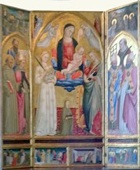
-
✴In the central panel, which depicts the mystic marriage of St Catherine, the Madonna and Child float on a cloud:
-
•St Catherine of Alexandria (with her wheel) stands to the right, accepting a ring from the baby Jesus;
-
•the titular of the nunnery, St Agnes (holding the Lamb of God) stands to the left; and
-
•St Elizabeth of Hungary (crowned and carrying roses) kneels below.
-
✴The side panels depict:
-
•SS Antony of Padua (with the flames of his eloquence in his hand), Louis of Toulouse and John the Evangelist in the right panel; and
-
•SS Herculanus, Constantius and Laurence (with his grill) in the left panel.
-
✴The panels in the upper register depict:
-
•the stigmatisation of St Francis, on the left;
-
•the Annunciation, in the spandrels of the centre panel; and
-
•SS Jerome, Onuphrius (Onofrio, Humphrey) and Paul the Hermit (who kneels in front of his cave), on the right.
-
✴The predella panels depict:
-
•the risen Christ appearing to St Mary Magdalene and insisting “nole me tangere” (do not touch me);
-
•St Catherine rejecting the marriage proposal of the king;
-
•St Elizabeth caring for the infirm; and
-
•the baptism of Christ.
-
✴The outer surfaces of the side panels (illustrated in the site of Musei d’ Italia) depict:
-
•the obscure Blessed Pavino del Bastone on the left; and
-
•St Ives (Sant’ Ivo di Bretagne) on the right. [St Ives, who died in 1303, was a Franciscan tertiary from Kermartin, Brittany. He trained as a lawyer and frequently defended people who were too poor to pay for legal advice. He was canonised 1347.]
Panels from a Triptych (early 15th century)
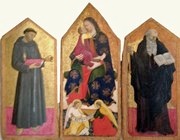
The panels from this dismantled triptych were transferred from the Franciscan Convento di Farneto, outside Perugia to the gallery in 1863. They represent the autograph work of the Maestro del Trittico del Farneto: recent scholarship discounts the identification of this artist with Pellegrino di Giovanni (as set out in the references given on the page on Pellegrino).
The panels depict:
-
✴the Madonna and Child, with two angels below holding a scroll [inscription?];
-
✴St Francis (on the left); and
-
✴St Antony Abbot (on the right).
Panels from a polyptych (ca. 1455)
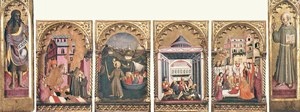
A document dated 1455 records a payment by Giovanni Montesperelli to Mariano di Antonio for a Maestà (now lost) that he had commissioned for his chapel in San Francesco al Prato. It is possible that this work was part of a polyptych that also included these six panels, which are attributed to Mariano di Antonio and which were first recorded in 1810, when they were transferred from San Francesco al Prato to the Accademia di Belle Arti:
-
✴Four of the panels, which depict miracles of St Antony of Padua (to whom this chapel was dedicated), probably came from the predella; and
-
✴the other two, which depict SS John the Baptist and Bernardino of Siena, probably came from the pilasters. The fact that St Bernardino, who was canonised in 1450, is depicted with a halo is consistent with this dating.
If these assumptions are correct, this is the only securely documented work by Mariano di Antonio.
Pietà and symbols of the Passion (15th century)
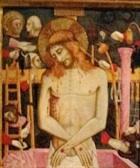
Room 8
Guidalotti Polyptych (ca. 1447)
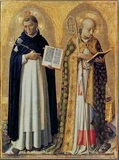
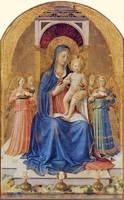
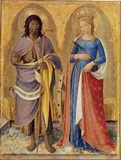
This polyptych was first documented in 1548 in a description of the Cappella di San Nicolò, San Domenico, which belonged to the Guidalotti family. This description noted that Elisabetta Guidalotti had decorated the chapel and identified Fra Angelico as the painter of the altarpiece. Elisabetta’s efforts in the chapel, and in particular the commission of an altarpiece from such a noted Florentine artist, were probably intended to help restore the prestige of her family after its disgrace following its part in the murder of Biordo Michelotti in 1398.
A 17th century document records that the altarpiece was commissioned in 1437, although modern art historians generally date it on stylistic grounds to the 1440s. The figure of St Nicholas of Bari seems to be a portrait of Pope Nicholas V. It has been suggested that Fra Angelico painted this polyptych in late 1447, en route from Orvieto for Rome.
The central panel of the polyptych depicts the Madonna and Child enthroned with angels. Four saints stand in fictive aedicules in two panels to the sides:
-
✴SS Dominic and Nicholas of Bari (identified as such on his stole) to the left; and
-
✴SS John the Baptist and Catherine of Alexandria (with her wheel) to the right.
The figures in these three main panels share a unified space behind the divisions imposed by the framing. This space has a natural appearance, despite the somewhat anachronistic gold background. It has been suggested that Fra Angelico was intent upon reconciling his own “modern” conception with his client’s desire for a sumptuous, albeit “old fashioned” appearance.
The other panels of the polyptych include:
-
✴two small panels (above the side panels of the main register) depicting the figures of the Annunciation;
-
✴six panels incorporated into each of the side pilasters depicting various saints; and
-
✴three predella panels, which depict scenes from the life of St Nicholas of Bari.
Although the chapel was undamaged when the vaults in the nave of San Domenico collapsed in 1614, the polyptych seems to have been removed soon after. The predella was displayed separately from the rest of the work by the early 18th century, when both parts were in the sacristy. Most of the panels escaped requisition in the Napoleonic period, but the predella panels were confiscated:
-
✴Dominique-Vivant Denon, the Director of the Musée Napoleon (later the Musée du Louvre) selected two of them in 1810, and they were duly shipped to Paris. Antonio Canova recovered them in 1815, when they were secured for the Pinacoteca Vaticana, Rome.
-
✴Agostino Tofanelli, the Director of the Musei Capitolini, Rome selected the third for this museum in 1812. It was returned to San Domenico in 1817.
The panels in San Domenico were moved to the gallery in 1860. They were assembled in a new frame in 1915, together with copies of the missing predella panels.
Room 9
Madonna della Pergolata (1446-7)
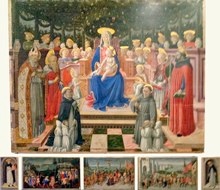
This important altarpiece is the earliest surviving work signed by Giovanni Boccati and one of the first altarpieces in Umbria with an undivided central field. The Confraternita di San Domenico bought the altarpiece at a very high price in 1446: their archives record that “Messer Angiolo”, who had originally commissioned it, no longer wanted it. They paid for minor additions to the work (see below) in 1497, the date given in the inscription on the base of the throne.
Francesco Mancini (see the page on the artist) has suggested that “Messer Angiolo” was, in fact, Angelo Geraldini di Amelia, who studied law at the Studium and then became its first non-Perugian Professor of Law (1444-6). During this period, he also acted as rector of the Collegio di San Gregorio (Sapienza Vecchia) and of the Collegio di San Girolamo (Sapienza Nuova). SS Gregory and Jerome feature in the altarpiece, and it might have been intended for one of the college chapels. (Another altarpiece of similar format, which was commissioned for the Sapienza Nuova in 1456 from Benozzo Gozzoli, is now also in the gallery - see below).
The confraternity bought the altarpiece after its rejection by Messer Angiolo and adapted for use in the Oratorio di San Domenico. It subsequently suffered serious damage and Giannicola di Paolo was commissioned to restore it in 1519. It was dismembered in 1780 and passed to the gallery in 1863, when the oratory and adjoining Convento di San Domenico were converted for use as a barracks.
The main panel depicts the Madonna and Child with the Doctors of the Church (SS Ambrose, Jerome, Augustine and Gregory) and a choir of angels under a flowery pergola. In the foreground, SS Dominic and Francis commend four of the brothers: it seems likely that earlier figures were replaced by representations of the penitent members of the confraternity when they took over the commission from Messer Angiolo. (St Francis would still have been appropriate because the confraternity was closely associated with the Confraternita di San Francesco).
The predella panels depict:
-
✴St Thomas Aquinas;
-
✴three fine scenes from the Passion (the capture of Christ; the road to Calvary; and the Crucifixion); and
-
✴St Peter Martyr.
It is likely that the two Dominican saints in the predella were also added after the change of commissioner.
Madonna dell’ Orchestra (ca. 1450)
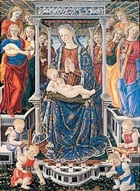
The gallery notes suggest that the altarpiece was originally in the friars’ church of San Simone del Carmine. Fabio Marcelli (see the page on the artist) has suggested that it might have been the fruit of the link between Giovanni Boccati and the scholar Tommaso Pontano, both of whom moved to Perugia from Camerino in the 1440s. Tommaso Pontano formed an association of lecturers from the Facoltà delle Arti of the University of Perugia in 1441 that originally met in the church of Santa Maria del Mercato. When this church was demolished in 1545, the association moved to San Simone del Carmine and it is possible that the Madonna dell’ Orchestra moved with them.
The altarpiece depicts the Madonna and Child enthroned, with an angelic orchestra. The throne is set in a meadow, and two angels kneel at its base to pick flowers. A goldfinch seems to peck the finger of the baby Jesus: the goldfinch is a symbol of the Passion because it feeds among thorns.
Gonfalone della Pietà (1479)
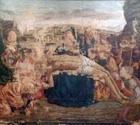
Gonfalon (1470s)
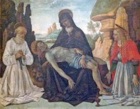
Room 10
Sapienza Nuova Altarpiece (1456)
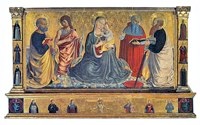
This altarpiece, which is signed by Benozzo Gozzoli and dated by inscription, was commissioned for the altar of the Cappella di San Girolamo of the Sapienza Nuova. The college gave it to the Academia di Belle Arti in 1816.
The main panel depicts the Madonna and Child seated on the ground in a meadow (an iconography known as the Madonna of Humility) against a gold background with SS Peter, John the Baptist, Jerome (to whom the chapel was dedicated), and Paul.
The predella depicts:
-
✴a central group of the Man of Sorrows with flanking half-length figures of the Virgin and St John the Evangelist;
-
✴half-length figures of SS Thomas Aquinas and Laurence to the left and SS Sebastian and Bernardino of Siena to the right; and
-
✴the Guidalotti arms at the extremes.
The other saints depicted on the sides of the frame are:
-
✴SS Dominic, Francis and Peter Martyr on the left; and
-
✴SS Catherine of Alexandria, Elizabeth of Hungary and Lucy on the right.
Elisabetta Guidalotti, whose brother Bishop Benedetto Guidalotti had founded the college, is documented as having made substantial donations to its chapel after her brother’s death and was named in the statutes of the college as the only woman allowed to visit it. The presence of the Guidalotti arms on the predella and of St Elizabeth among the depicted saints suggests that she commissioned the altarpiece.
Galleria Nazionale: Sala Podiani and Sala Conferenze Rooms 1-3 Room 4
Rooms 5-6 Rooms 7-10 Rooms 11-16 Room 17 Rooms 18-20 Cappella dei Priori
Rooms 22-28 Rooms 29-32 Rooms 33-40 Deposit
Return to Museums of Perugia.
Return to Walk I.



